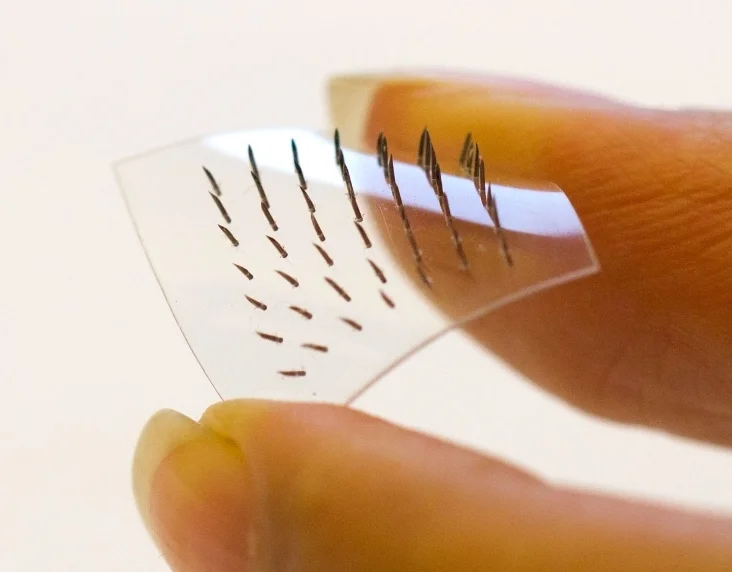Microneedles unlock curcumin's therapeutic potential

While turmeric root has been used medicinally throughout the world for centuries, science has found that its main chemical component, curcumin, breaks down in the body before its ultimate benefits can be achieved. An exciting collaboration among Carnegie Mellon University researchers Sai Yerneni, Phil Campbell, Burak Ozdoganlar, and Ezgi Yalcintas has created an approach to uniquely enable the use of curcumin as a robust therapeutic.
Curcumin is an anti-cancerous, anti-inflammatory, anti-oxidant, and anti-bacterial polyphenol found in turmeric. However, its isolated, pure form is not stable due to its rapid degradation within and clearance from the body. This represents one of the largest obstacles to its translation as a practical therapeutic. It also serves as motivation for researchers to explore encapsulation strategies to protect the curcumin inside the human body.
One such encapsulation approach is to incorporate curcumin into exosomes. Exosomes are nanometric extracellular vesicles that the human body uses for cell-to-cell communication by moving proteins, lipids, nucleic acids, and metabolites. By placing curcumin in exosomes, the chemical is stable enough to travel throughout the body and achieve its therapeutic effect. Although other researchers have attempted to use exosomes to deliver curcumin, the improvement in curcumin's stability was insufficient for its use as a therapeutic.
Albumin, a natural stabilizer protein that occurs in the human body, can address this challenge. Yerneni, a postdoctoral researcher in chemical engineering, and Campbell, a research professor of biomedical engineering, have developed a hybrid approach to leverage the unique properties of both exosomes and albumin. They engineered an exosome-albumin hybrid system to deliver therapeutics, including curcumin.
"Prior attempts to load curcumin into various lipid membrane-bound nanoparticles suffered from the curcumin either being unreliably loaded or subject to short retention times, whereas the inclusion of albumin binds to the curcumin keeping it in the lumen of the exosome, protected from degradation," said Campbell.
Although albumin-curcumin association and exosome encapsulation could provide a stable drug delivery system, targeted delivery to desired tissues or organs remain another challenge. When injected into the blood, most of the exosomes tend to accumulate in the liver rather than reaching the targeted organ or tissue. To this end, an attractive approach is to deliver the curcumin-albumin-containing exosomes using microneedle array patches for skin targeted applications.
Microneedle arrays (MNA) contain tens or hundreds of needles, each as thin as a human hair and invisible to the naked eye. Through a manufacturing and application process first, these micro-scale needles are arranged in an array format on a patch smaller than a penny. Dissolvable microneedles are formed by mixing the drug—exosomes in this case—with a type of sugar and solidifying them into their shape.
When inserted into tissue, the needles dissolve away and deliver the drug in a targeted and precise manner. Due to their small size, microneedles do not cause tissue damage. As such, they can be used as a pain-free way to deliver therapeutics into or through the skin, improving patient compliance and targeted delivery. Notably, the microneedle patches can be administered by the patients themselves without any specialized equipment or training.
The researchers found another major advantage to using MNAs. When the exosome-fortified curcumin compounds were incorporated into MNAs, the team found that the stability of these compounds at room temperature increased dramatically. The system could be stored for up to a year without needing cold storage.
"This is big because of one of the major drawbacks of current vaccines are the logistics of transportation requiring cold storage," Yerneni said. He explained that this especially disadvantages poorer countries that cannot facilitate long cold storage supply chains. Yerneni is optimistic that this technology can overcome those hurdles.
A collaborative journey
Yerneni and Campbell had not needed to go far to find a collaborator for delivering exosomes by using microneedle arrays because one of the world's leading experts in the technology was just down the hall. Burak Ozdoganlar, a professor of mechanical engineering, had been leading efforts to develop different microneedles for more than a decade with the late Lee Weiss, a professor in Carnegie Mellon's Robotics Institute.
One of the original inspirations for MNAs came from Weiss, who conceptualized the idea of "micro-velcro," or micro-barbs, an array of titanium projects in the shape of an arrowhead. Ozdoganlar and Weiss worked together in the mid-2000s, developing manufacturing methods to bring the "micro-velcro" to fruition. Later, Ozdoganlar collaborated with medical researchers from the University of Pittsburgh to demonstrate the application of MNAs for a range of diseases and conditions including skin cancer, and more recently, for COVID vaccination.
Yalcintas, a former Ph.D. student from Ozdoganlar's research group, worked closely with Yerneni on the curcumin project. "This was a true collaboration between two outstanding research groups. Thanks to Ezgi and Sai's excellent work, we successfully demonstrated the local delivery of curcumin to the skin and its efficacy in blocking and subsiding inflammation," said Ozdoganlar. "This can greatly impact treating a range of skin conditions, and possibly, various skin cancers."
Published in Acta Biomaterialia, the team's research demonstrates that the exosome/MNA hybrid system is an effective way of delivering curcumin to the skin. This will allow doctors to utilize curcumin as an all-natural therapeutic. The team has shown this to be an effective treatment for lowering local skin inflammation in small animal models, but further research is needed to explore curcumin's other properties.
Next, the team plans to conduct further experiments using disease-specific animal models to prove that the benefits of curcumin can be realized using an exosome-albumin delivery system and microneedle arrays.
"We successfully loaded exosome-albumin delivery system with curcumin," Yerneni said. "This technology is being extended to deliver other drugs and potentially control other skin diseases such as cancer (melanoma), psoriasis, and skin ulcers."
Source. Image: gv-image-1/shutterstock





